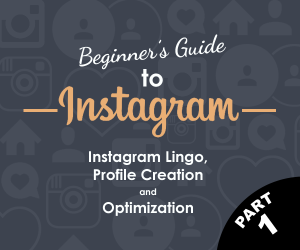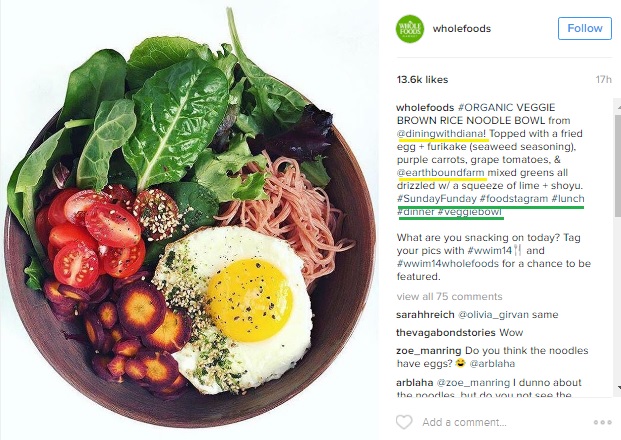 Want to build authority in your industry? Could your products and services use a boost in online fan base?
Want to build authority in your industry? Could your products and services use a boost in online fan base?
Instagram’s 300 million daily users are waiting for you.
Any business, any product or service that can tell their story visually should use Instagram to increase brand awareness and web traffic.
You might be wondering how to use Instagram for business. Well, it’s not as simple as posting pictures of sunsets and yummy food.
Instagram Tutorial: New Words and Phrases You’ll Encounter
I know for some people, exploring a new website or app can be overwhelming at first. Lots of new terms and a new user interface sometimes make it hard to adapt.
So let’s start this Instagram tutorial by understanding the different terms used:
- Feed: Your entire photo timeline or gallery.
- Following: The users who are subscribed to your feed. Every time you upload an image or video, it may show up on their home page. Like Facebook, Instagram has its own algorithm that dictates which pictures appear on the top of your home page.
- Home page: Shows pictures and videos from other users that you follow.
- Like: Symbolized by a heart ❤. Its function is similar to Twitter and Facebook’s like, people click it to show that they like your picture or video.

- Username: What you use to login, and what other users type to call your attention in photos and comments. It’s also what appears beside your profile picture. In the example below, shoes and accessory brand Aldo’s username is ‘aldo_shoes,’ labeled as ‘1.’

- Profile Picture: The picture that appears beside your profile bio. Instagram profile pictures are circular and 110 x 110 pixels in size, so users are asked to crop their chosen picture after uploading it online. Don’t worry, it’s easy. In the example above, the profile picture is labeled as “2.”
- Profile Bio: A short, 150-character description of what your profile is about. Since you’re going to use it for your business, share details about you products, how it helps your clients and what people can expect from your Instagram account.
- Link: Unlike other social networks that allow you to include a link in every post, Instagram only allows one link—and that’s on your profile bio. Check out the example above from Aldo.
- Tagging: Starts with the “@” sign followed by a username, it’s what you do to identify people in your photo, especially in group pictures. It’s also used to tag other users for crediting them, or marketing purposes. Below is an example of a user (thehuskylove) tagging another user, @maruhusky.

- Caption: The description on a photo or video you upload. Captions can also include hashtags, symbols, emoji, and tags of other people. Below is a picture and caption from @natgeo. Captions can have a maximum of 2200 characters, but only the first 240 characters (give or take) are shown, the rest are hidden and will only show after you click the ellipsis symbol (…).

- Hashtag: A word or phrase, without spaces, preceded by the hashtag (#) sign. A hashtag creates a clickable link that lets you see all other posts with the same hashtag, including posts from people you don’t follow. It’s a good way to help your post reach a wider audience.
Popular Instagram hashtags include #beach #followmeto and #foodporn. But you can’t use that for everything. Only use hashtags relevant to the image or video you posted to avoid annoying other users. While Instagram’s hashtag limit is 30, more than five hashtags in a post can get tiresome. In the example above from NatGeo, they used the hashtags #Baha, #mexico, #whales, and #conanp.
- Filters: overlays and photo effects that users can add to edit a picture’s color balance, contrast, and exposure. Instagram has tons of filters that it takes a while to figure out which works for the kind of image you’re uploading. Check this article for a primer on the different before and after effects of filters on your Instagram uploads. I’ll discuss filters in greater detail on the next Instagram tutorial.
- Stories (aka Instagram Stories): a relatively new feature that allows users to upload photos and videos more frequently, without the risk of getting unfollowed due to over posting. With Stories, your uploads disappear after 24 hours. Stories allows you to doodle on images to customize it.
How to Use Instagram for Business Growth and Marketing Success
Use Hashtags Wisely
Don’t be the king or queen of hashtags. You know the kind. An Instagram user who uploads a picture of the beach with 10 hashtags. Sometimes, they don’t bother with a description. Just #beaches #sun #travel #vacay is enough. Using hashtags like this annoys your followers, and doesn’t help your content reach a wider audience—not as wide as you might think.
Yes, #beaches may have more posts and impressions than a more specific hashtag, such as #beachwedding or #redondobeach. But that also means you have more competition with that hashtag. It may have a wider range but your chances of getting any type of engagement from other users are lower.
It’s better to use a combination of popular and not so popular hashtags that are both relevant to your post.
For instance, if you’re in the diet and fitness industry, using the common and popular hashtags #exercise, #diet, and #fitness will boost your post’s reach. But don’t forget to mix in less popular hashtags to lengthen your upload’s life in Instagram’s search results. Following the example earlier, less popular and more specific hashtags could be #p90x, #atkinsfood, or #exerciseguide.
You might know how to use Instagram for business, but if your posts aren’t showing up in people’s feeds, then it’s not worth it.
This post from Wholefoods has a good mix of less popular (green) and common hashtags (yellow).

How do you know which hashtags to use?
Use a combination of brand specific hashtags, such as taglines or phrases you created for your business and customers can identify you with. Industry related hashtags also work well.
Not sure how popular a hashtag is? Clueless about which hashtags to use? Check out the following tools to monitor and explore different hashtags:
Use Trackable Links
How do you get people to click on your link if it doesn’t appear with your posts? Update your bio link every time you post something related to it on Instagram.
Publish a new blog post? Having a sale? Post a relevant image then write “link in bio” on your caption. That’s how many online influencers and business owners do it.
Use trackable links with UTM codes so you can track the traffic coming from your Instagram page. Shortening the links allow you to use UTM codes to full extent, without taking up a lot of the precious 150-character limit in your bio.
Camp Brand Goods uses this strategy, their profile bio has a shortened link leading to their latest blog post.


Camp Brand Goods Instagram shortened URL
Camp Brand Goods latest blog post
Connect Your Account to Other Networks
Instagram makes it easy to connect it with your other social networks, so you can cross-promote posts. You can share your Instagram posts on your business Facebook, Twitter, Flickr, and Tumblr accounts.
Cross-promotion shows followers on other social networks that you’re also on Instagram. Chances are some of them will follow you there, too.
Stay Tuned for Part 2
That’s about it for this beginner’s guide to Instagram. Tune in next week for part two: basic photo editing tips that boost share and comments. I’ll also dive into more detail on how to use Instagram for business, and how to get more followers through sharing and engaging other users.
